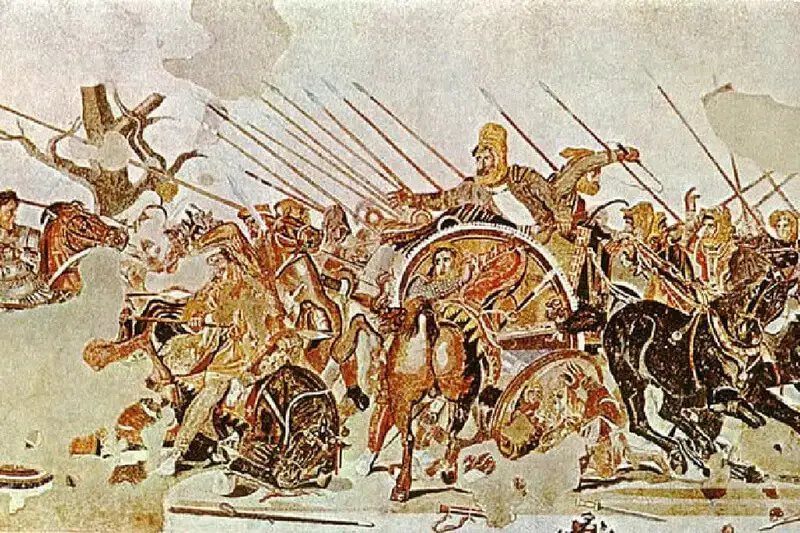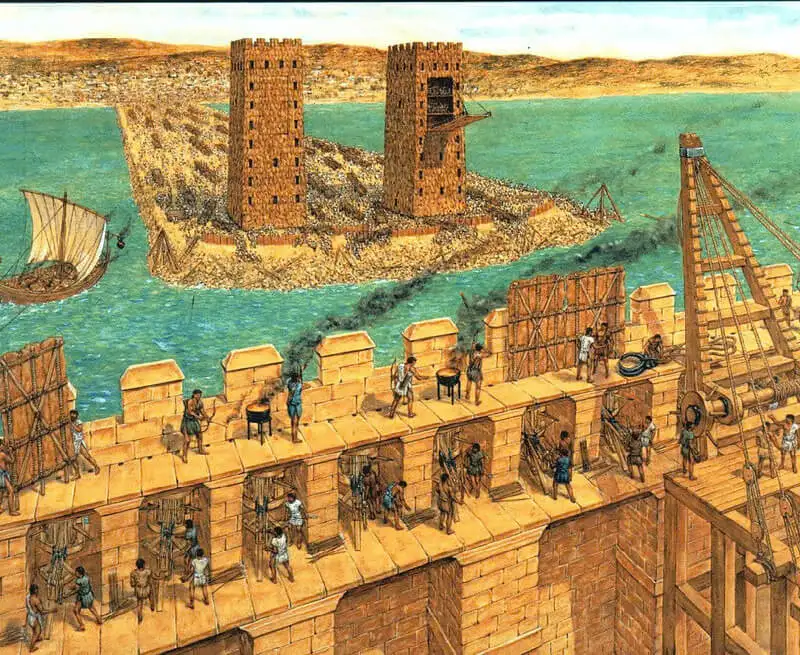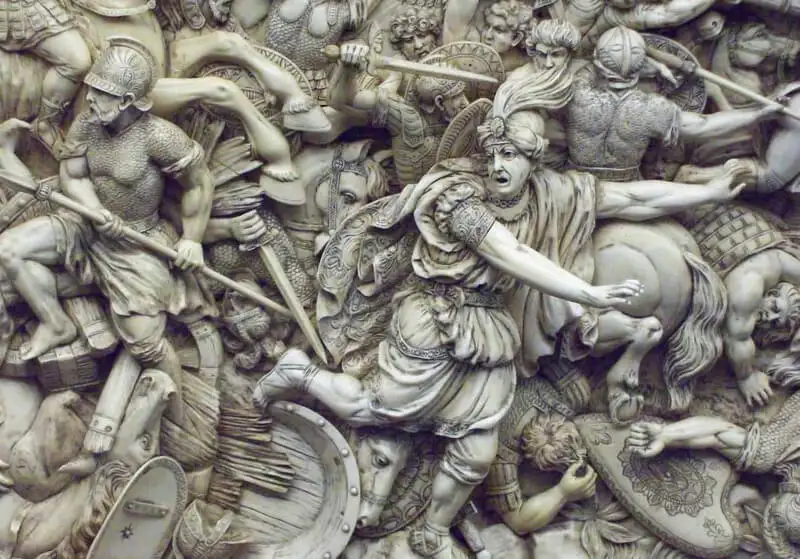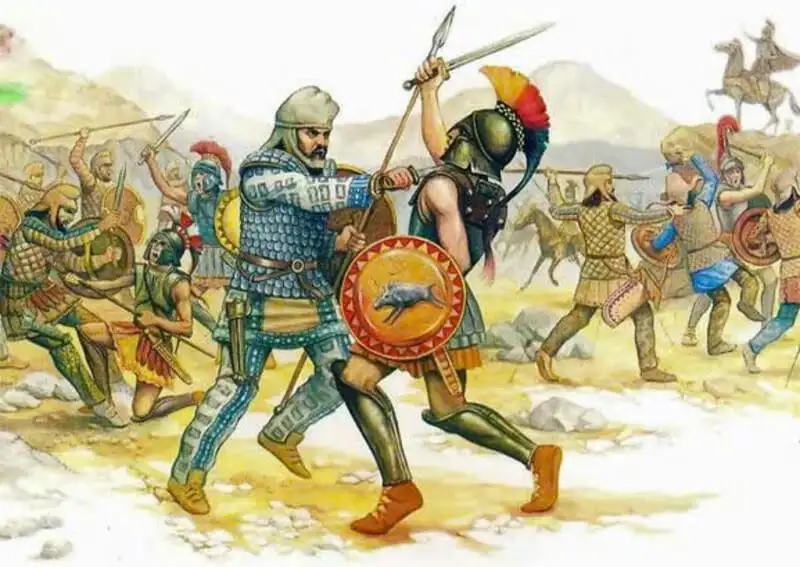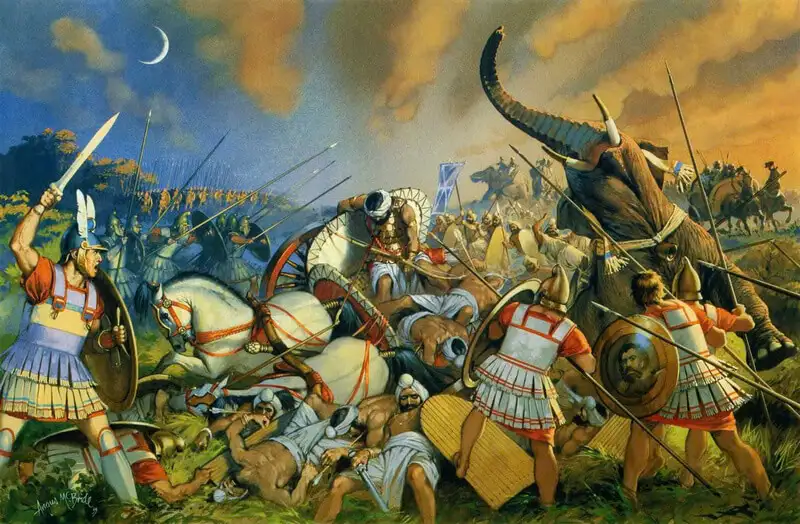Alexander the Great, the young king of Macedon, stands as one of the most exceptional military leaders in human history. With extraordinary talent, he expanded the Macedonian Empire from Greece to India, leaving an indelible mark with resounding victories like the Battles of Gaugamela and Hydaspes. Throughout his conquests, he not only reshaped the world map but also spread Hellenistic culture across the Middle East. Join Pywar as we delve into the details of the life, achievements, and legacy of this immortal king, where history comes alive on every page!
Who Was Alexander the Great?
Alexander the Great is regarded as one of the greatest military leaders in history. In 336 BCE, at the age of 20, he succeeded his father, Philip II, and became king of the Macedonian kingdom in Greece. Soon after, he embarked on a series of aggressive military campaigns to consolidate the territories under his control and expand eastward.
As king, Alexander successfully conquered the first Persian Empire, extending Macedonian territory to regions that today include Pakistan and India. During these campaigns, he spread Greek culture throughout the Middle East, laying the foundation for the development of Hellenistic culture after his death in 323 BCE.

- Alexander the Great – A symbol of military leadership and a monumental legacy. (Source: Collected)
Alexander’s military career is distinguished by a series of resounding victories, often achieved despite his army being outnumbered. Historians note that Alexander consistently led his troops from the front lines in every battle. This bravery resulted in him sustaining severe injuries multiple times, including a sword slash to the head, a deep thigh wound from a blade, an arrow that pierced his lung and nearly killed him, and a catapult projectile lodged in his shoulder.
Alexander’s achievements and campaigns not only altered military history but also left a lasting legacy, including environmental impacts from major sieges whose traces remain visible to this day.
The Conquests of Alexander the Great
The Battle of Thebes, 335 BCE
When the Greek city-state of Thebes (not to be confused with Thebes in Egypt) rebelled against Macedonian rule, Alexander swiftly led his army to crush the uprising. After securing victory in the battle—one of his first major campaigns—Alexander ordered the entire city to be burned to the ground.
According to Paul Cartledge, emeritus professor of Greek culture at the University of Cambridge, one reason Alexander razed Thebes was to send a stark warning to other Greek city-states: “Do not revolt against Macedonian rule.” However, this strategy was not entirely effective, as Sparta also rebelled (albeit unsuccessfully) in 331 BCE. At that time, Alexander was conducting campaigns in Asia to conquer the Persian Empire.

- Alexander the Great leading his army in the Battle of Thebes, 335 BCE. (Source: Collected)
The Battle of the Granicus River, 334 BCE
Alexander the Great’s first major victory over the Persian Empire took place at the Granicus River in Asia Minor (Anatolia), located in present-day western Turkey. In this battle, Alexander invaded Persian territory and faced off against the satraps (regional governors) of the empire.
The resounding victory at Granicus affirmed Macedonian dominance over Asia Minor, marking the beginning of a broader invasion into Persian lands. This success bolstered Alexander’s confidence, propelling him deeper into the empire and preparing him to confront the forces of King Darius III.

- Alexander the Great securing a resounding victory in the Battle of the Granicus River, 334 BCE. (Source: Collected)
The Battle of Issus, 333 BCE
The first confrontation between Alexander the Great and King Darius III, ruler of the Persian Empire, occurred at the ancient town of Issus, in what is now Turkey. Like the Battle of Granicus, Issus was situated on the western edge of the Persian Empire.
Professor Paul Cartledge notes that this battle held immense significance. He poses the question: “Why did the king of the Persian Empire choose to confront Alexander directly on the western fringe of his domain?” Cartledge suggests that Alexander’s campaign in Asia Minor posed such a threat that Darius felt compelled to personally lead the Persian army in a major battle.
Alexander’s forces defeated the Persian troops, marking a critical victory in his quest to conquer the Persian Empire. However, Darius survived to face Alexander again two years later in the decisive Battle of Gaugamela.

- Alexander the Great facing off against King Darius III in the Battle of Issus, 333 BCE. (Source: Collected)
The Siege of Tyre, 332 BCE
Following his decisive victory over Darius III at Issus, Alexander advanced to Tyre, one of the oldest continuously inhabited cities in history, located in present-day Lebanon. At the time, Tyre was situated on an island surrounded by formidable walls, posing a significant challenge to any invading army.
Alexander constructed a causeway from the mainland to the island and installed siege towers along it to assault the city. The siege succeeded, and Alexander captured Tyre. However, the causeway he built had an unintended historical impact. Over time, sediment accumulated around it, forming a permanent isthmus that connects Tyre to the mainland today.

- Alexander the Great conducting the Siege of Tyre, 332 BCE. (Source: Collected)
The Battle of Gaugamela, 331 BCE
The final clash between Alexander the Great and Darius III took place at Gaugamela, in present-day Iraq. Despite Darius’s army vastly outnumbering Alexander’s forces, Alexander once again defeated the Persian king in this decisive battle. With the victory at Gaugamela, Alexander effectively gained control of the Persian Empire.
Though Darius survived the battle, he was assassinated in 330 BCE by one of his own satraps. Professor Paul Cartledge remarks: “After the victory at Gaugamela, the remainder of the Persian Empire lay entirely within Alexander’s grasp. It was only a matter of time before he fully controlled it.”

- Alexander the Great securing a decisive victory over King Darius III at the Battle of Gaugamela, 331 BCE. (Source: Collected)
The Battle of the Persian Gate, 330 BCE
The ancient city of Persepolis, in present-day Iran, was one of the key capitals of the Persian Empire under Darius III’s reign. After defeating Darius, Alexander marched toward Persepolis through the Persian Gate—a treacherous mountain pass guarding the city’s entrance.
Here, Alexander’s army overcame the Persian defenders attempting to halt his advance. This victory allowed Alexander to seize Persepolis and subsequently order the city burned—an iconic act symbolizing the fall of the Persian Empire.
After securing Persepolis, Alexander continued marching eastward to establish control over the expanded Persian Empire’s territories, including present-day Afghanistan, Pakistan, and India.

- Alexander the Great fighting in the Battle of the Persian Gate, 330 BCE. (Source: Collected)
The Battle of Hydaspes, 326 BCE
The final and one of the greatest military victories of Alexander the Great occurred at the Hydaspes River (now the Jhelum River) in present-day Pakistan. Here, Alexander faced King Porus and encountered a unique challenge for the first time: war elephants. Porus’s army deployed approximately 200 war elephants, presenting an unprecedented test for Alexander.
Though the Battle of Hydaspes brought Alexander closer to defeat than ever before, he and his army emerged victorious. Rather than destroying Porus, Alexander allowed him to continue ruling the region on the condition that he swear allegiance to Alexander, now the king of the Persian Empire.
After securing the eastern frontier of his empire, Alexander returned to its central regions. However, this marked his final military campaign. In 323 BCE, Alexander fell ill and died in the ancient city of Babylon (now in Iraq). The cause of his death remains a mystery. The passing of the 32-year-old king, without a clear heir, triggered a series of wars as his generals vied for control of the vast empire he left behind.

- The Battle of Hydaspes: Alexander the Great facing King Porus and his war elephants, 326 BCE. (Source: Collected)
(Source: Collected)
Conclusion
Alexander the Great’s life and career are a testament to his ambition for conquest and exceptional leadership. From victories at Granicus, Issus, Gaugamela, and the Persian Gate, he built an empire that transcended its era. Though he died at 32, Alexander left a profound legacy in military, cultural, and political spheres, ushering in a new epoch in human history. Join Pywar to explore more about historical heroes and in-depth articles on world war history.
Translated by: Le Tuan
Source: history.com – Alexander the Great: 6 Key Battles and a Siege





